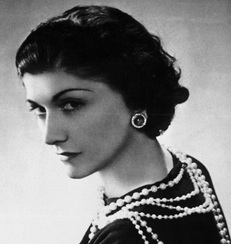 Coco Chanel was born August 19, 1883, as Gabrielle Bonheur Chanel in Saumur, France, although she was known to claim 1893 as her birthdate later on in life, essentially declaring herself a decade younger than she was. While Chanel’s namesake is now synonymous with luxurious goods and timeless designs, her miserable childhood provided a stark contrast to the life and career she carefully invented and curated for herself as an adult. Like her age, Chanel was infamous for disguising her past with distortions and half-truths to conceal the unfortunate circumstances of her younger years. Stories she would recount would include claiming her birthplace as Auvergne instead of a workhouse in Loire Valley, as well as tales of her father sailing for America, leaving her with wretched aunts who mistreated her. Chanel was, in reality, raised in poverty as an illegitimate child. Chanel’s mother was a charity hospital’s laundrywoman while her father was a clothes peddler. Upon her mother’s death, her father dispersed their children to various family members. Now abandoned and orphaned, Chanel herself was sent to a Catholic orphanage to be raised by nuns, where she learned to become a seamstress. While Chanel loved to embellish her sewing just as much as her stories, she first and foremost sewed as a living and not as an art. At 18, she left the monastery life to work for a tailor, supplementing her income as a singer at private clubs and venues, and earning her lifelong nickname of “Coco.” Some say her name came from soldiers who attended her concerts; others claim it originated from one of her songs. Yet independent sources claim that Chanel herself derived it from the French term, “cocotte,” for kept woman -- a fitting word, perhaps, as her life’s amours involved being a mistress to Etienne Balsan, an affluent textile heir and former military officer, and later on leaving him for his wealthy English friend, Arthur “Boy” Capel. Chanel’s relationships with both men were essential to her foray into the fashion world. Over the course of more than a decade, she received financing from the two friends for her sartorial ventures, starting off with designing and selling hats while living at Balsan’s chateau, and progressing to opening up her first boutiques and shops from Paris to Deauville. In 1919, Capel was killed in a car accident. His relationship with Chanel had endured, in spite of him marrying someone else the year prior, in 1918. To commemorate his death, Chanel commissioned a memorial at the site of the accident, and was later known to tell a friend that she lost everything when she lost Capel. Fashion historians might not agree with her, however, as Chanel’s influence grew exponentially throughout the 1920s and 1930s with revolutionary designs, from her loose, borrowed-from-the-boys jersey dresses, to her jacket suits and little black dresses, a color that until then was considered to be appropriate only for mourning. Her focus on simple yet chic and comfortable construction for women’s clothes were well-appreciated during a period of history were women typically had constricted themselves and their bodies with corsets and other wired undergarments. In 1925, she boldly launched her epononymous scent, Chanel No. 5, the first of any perfumes wearing a designer’s name at the time. Her fame and success in the fashion world is still prevalent today with Karl Lagerfeld at the brand’s helm, consistently pulling designs from Chanel’s archives for modern takes on clothes and accessories. Films of Chanel’s life took liberties of rewriting her history as much as she did, from 1981’s Chanel Solitaire, to the 2008’s television movie, Chanel, which overlooked the designer’s connections to Nazi Germany. The 2009 feature, Coco Before Chanel, also does not address the designer’s known anti-Semitism. Having never married, Chanel retained her mademoiselle status until her death in 1971. The icon passed in her rich and opulent apartment at The Ritz, leaving behind a far more glamorous legacy to the world. She remains to this day the only fashion designer to have been included on Time Magazine’s list of the 20th century’s 100 most influential people.
0 Comments
|
Archives
July 2017
Categories
All
|
 RSS Feed
RSS Feed